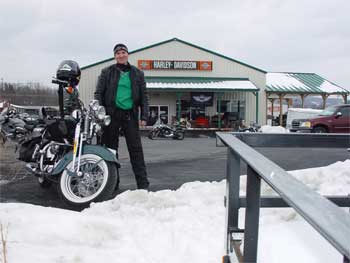Winter Riding
|
Disclaimer:
|

Most motorcycles should ride just fine in winter. |
|||||||||||
|
Mechanical
Considerations by: Chris Loynd Disclaimer #2: I preface this section by asserting that I am most decidedly NOT a mechanic, let alone a motorcycle mechanic. Since there are so many kinds of bikes, my opinions offered here are vague and broad generalities. Please, if you have any concerns, speak with your motorcycle dealer�s service department about the winter foibles � if any � for your particular model motorcycle. I can say that the Polar Bear Grand Tour includes most every bike brand you ever heard of, air and water cooled alike. Speaking of air and water cooled engines, I saw this segment on the History Channel. Early in the last century, when they were trying to open up Alaska even in winter, airplanes were an obvious answer to conquer the vast distances. First they tried conventional planes with water cooled engines. But aviation pioneers never could get one to run reliably. So they turned to the older, air cooled engines. If they could get those big rotaries to turn over, they would keep running in the severest conditions. Connecticut winters are not Alaska extreme. Nevertheless, cold temperature does challenge many mechanisms. Certainly you want your bike to be in top condition. Not just because winter riding may be harder on it. It is just a lot less fun waiting for a tow truck in twenty degree weather. Most motorcycles run heavyweight oils. They get pretty thick at very low temperatures. You may want to adjust your oil weight or change to synthetic. Once you get the bike started, it will take a surprisingly long time for the engine to get up to operating temperature. One precaution is to make sure you go for a decently long ride. Condensation happens naturally in winter. Over time your oil becomes contaminated with water. A long ride will heat things up enough to boil off the water. A short ride only exacerbates things. Batteries lose a lot of cranking power to the cold. A battery tender is a wonderful thing. It keeps your winter battery at full charge, ready to go. By cycling the battery charge it keeps it fresh and extends battery life. But a long ride will charge your battery just as well. Most motorcycles are not charging at idle or low RPMs. You need to ride a while at sustained speed to recharge the battery. You also want to make sure you do not overload the battery with too much amperage going to electric clothing, heated seat, heated grips, driving lamps, etc. One prospective Polar Bear, an apartment dweller without a garage, asked a good question about his battery freezing, sitting outside in the cold, cruel winter. A quick check of motorcycle battery manufacturer Yusa�s web site assuaged his concerns. Their product manual explained that a fully charged battery can be stored at sub-zero temperatures with no concerns. It takes minus 75 degrees F to freeze electrolytes in a charged battery. However battery discharge strips electrolytes from a battery�s solution, leaving more water by percentage. A discharged battery�s electrolyte begins to ice at just 27 degrees F. An alternative for non-garage owners is to bring the battery inside. If it is easy to access and disconnect, you can then keep your battery on a tender inside your warm apartment. It will have more cranking power than my motorcycle battery on its tender in an unheated garage. Tires can lose pressure more easily in cold than warm weather. Motorcycle tires can lose upwards of five psi per day in colder months, according to a Harley-Davidson article. So check tire pressure before every ride. Also be careful riding on cold tires. In winter it can take as long as 20 minutes for your tires to warm to their ideal level of stickiness, depending upon your riding speed. So don�t throw the bike into any corners right out of the driveway. I understand those of you with chain-driven bikes may have some additional winter concerns. Certainly you want to keep up with maintenance. Winter salt and sand do not contribute to the effectiveness of your chain lube. |
||||||||||||
| Back to top
Back to the Polar Bear Blog
|
||||||||||||